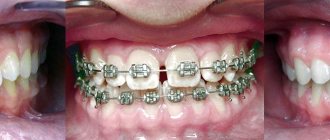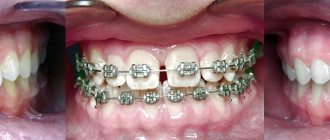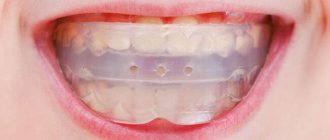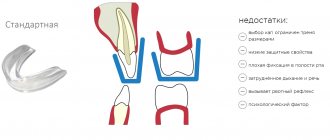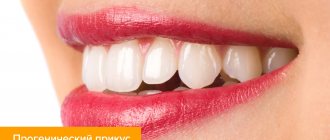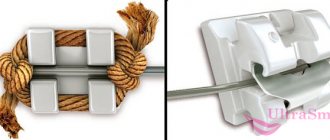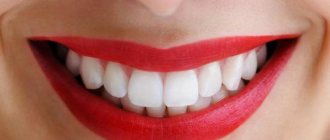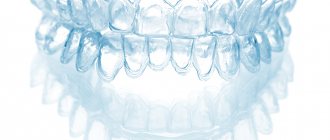- Development of headaches and discomfort when moving the jaw.
- Uneven or excessive grinding of teeth.
- Frequent caries even with proper and regular oral care.
- Incorrect jaw position, changing the shape of the face and worsening appearance.
- Psychological problems due to embarrassment when smiling.
Since not all children can be fitted with full-fledged braces, it is necessary to use alternative means.
Among the most popular and effective are children's mouthguards for correcting bites. At the Novodent clinic, we are ready to accept small patients with their parents, answer all their questions and begin effective bite correction.
Mouth guards as an alternative to braces
Straightening crooked teeth, of course, should be done in childhood. However, many parents simply do not pay attention to this problem. Therefore, the question of orthodontic treatment for most patients arises in adolescence or adulthood. However, not every teenager or adult will agree to put braces on their teeth and follow not the most simple rules of hygiene. Until recently, there was no alternative to braces. But with the advent of aligners - mouth guards for straightening teeth, it became possible to undergo orthodontic treatment unnoticed by others and with comfort for yourself. Moreover, this applies not only to adults, but also to teenagers, for whom their own technology of transparent mouth guards has been developed. Like aligners for adults, they are a set of removable aligners, completely invisible to others, which can correct most dental anomalies, provided that the attending physician has the appropriate experience.
Features of a mouth guard for teeth straightening
Removable aligners for teeth straightening for adults are made from a special transparent material. Today, their range of applications is no different from the capabilities of braces, but treatment with mouth guards is much easier and more enjoyable. The main advantage of the system is that they are not visible, whereas braces, whether sapphire or ceramic, are still visible on the teeth. Of course, there are also lingual invisible braces, which are attached to the teeth from the inside, but they have a fairly long period of adaptation, just like other brace systems. Typically, it takes several weeks for the patient to adapt to braces, during which it will be uncomfortable for the wearer to eat and talk. In addition, braces, like other types of mouth guards, rub the mucous membrane and “scratch” the teeth, which causes some discomfort. But correcting a bite with a mouth guard is as comfortable as possible for patients.
Aligners for children
Aligners are most often used to straighten already permanent teeth at an early age. They are absolutely transparent, miniature in size and accurately follow the shape of the teeth.
You can only notice a mouthguard in a person’s mouth from a very close distance. It has minimal effect on articulation (pronunciation of sounds).
Be like a star!
Persuading a child to wear a mouth guard all the time is quite difficult, but it is possible. Children often imitate performers and actors. A worthy argument in favor of aligners is that they were once worn by such stars as Justin Bieber, Khloe Kardashian, Zac Efron, Tom Cruise. They calmly appeared in public, performed, and communicated with people.
Transparent mouth guard for teeth straightening and trainers
Dental aligners for straightening teeth are often confused with trainers and retainers, which are worn after braces are removed. Meanwhile, these are completely different orthodontic devices, which have different indications for use and have different effects on the dental system. Trainers are somewhat reminiscent of sports mouthguards to protect teeth from impacts. With their help, it is possible to correct malocclusion and dental position in children from three years of age, which have developed as a result of impaired breathing and swallowing functions, as well as due to numerous childhood bad habits, such as prolonged sucking of a pacifier or bottle. Trainers are particularly effective for treating early stage malocclusions and are therefore mainly suitable for children under 11 years of age. A retainer is usually prescribed to consolidate the results of orthodontic treatment and adjust muscle function in accordance with the bite. It is bulkier than a clear aligner for adults and is made of flexible silicone.
Trainers for children
Trainers are mainly used at an early age - from 3 to 9 years, during the period of baby teeth and mixed dentition. They correct defects in the development of the dental system associated with various dysfunctions.
Often problems with bite are complex, for example associated with improper breathing. In particular, a small child may have enlarged adenoids, he cannot breathe fully through his nose and uses his mouth to do this. If this continues for a long time, then a number of problems arise.
- The upper jaw is formed incorrectly - it narrows in the lateral sections, as a result there is not enough space for the eruption of permanent teeth.
- Improper development of the upper jaw causes developmental defects in the lower jaw, and diction suffers from this.
- The muscles of the lips, tongue, and cheeks also do not work correctly, which negatively affects the aesthetics of the face: the neck is pulled forward, the lower third of the face lengthens, and the middle zone is poorly developed.
- The child cannot swallow fully, which affects digestion.
In this case, the orthodontist may recommend wearing trainers - they help the eruption of permanent teeth, develop the muscles of the oral cavity, help restore proper breathing, and shape posture. These mouthguards are worn during the day for several hours and throughout the night. The treatment process can be supplemented with developmental exercises.
Silicone aligners for teeth straightening
Treatment with clear aligners minimizes the risk of medical error. The fact is that while wearing braces, the dentist takes a very active part and is independently involved in their installation and corrections, and in the process he may make a mistake. As a result, the course of treatment and, as a consequence, its outcome may be disrupted. In addition, during the next correction, there is a risk of “tightening” the ligature, which can cause severe pain and “eversion” of the roots of the teeth. A transparent mouthguard for straightening teeth for adults acts on hard tissues very smoothly and, if the doctor initially correctly calculated the trajectory of teeth movement, cannot disrupt the course of treatment.
Manufacturing process and treatment features
First of all, the patient goes for a personal consultation with his doctor. He must also undergo a complete sanitation of the oral cavity, heal all existing carious cavities and eliminate inflammation.
Only after this does the specialist begin making the mouthguard itself:
- An impression is made of the patient's jaw, from which the doctor can recreate a plaster model of the jaw.
- Next, a 3D model of the correct position of the teeth is created, which the doctor will strive for.
- If the patient is satisfied with everything, you can move on to the next stage.
- It is important to know that the course of treatment requires up to 25 drops. All of them have a specific numbering and must be used sequentially one after another.
Capabilities of the mouthguard
The mouth guard will help cope with the following ailments and abnormalities:
- Very large gaps between the teeth or, conversely, excessive crowding in the row.
- Minor malocclusion.
- A noticeably prominent arrangement of one or more teeth relative to others.
- Loss of teeth due to injury and, as a result, malocclusion.
In addition, mouthguards are often used in childhood, when there is improper eruption of the first and molar teeth.
Mouth guards or braces
First of all, it is worth noting that braces systems will cost the patient much less than mouth guards. However, before making a choice, you should consider several points and understand the differences between these two methods.
Braces are made of durable metal or equally durable ceramics, and mouthguards are made of plastic. As a result of wearing braces, soft tissues may be injured, and the enamel may change its shade. Mouthguards are absolutely safe and non-traumatic.
Advantages of the mouth guard:
- The design is removable, which allows you to clean your teeth and the product itself more thoroughly. This reduces the risk of developing caries.
- Custom-made mouthguard simplifies the installation process. Braces made to certain standards are not suitable for everyone.
- Mouthguards are not noticeable to others.
Despite many advantages, mouthguards, unfortunately, cannot cope with very complex pathologies.
Plastic mouth guards for straightening teeth in teenagers
Despite all the advantages of plastic mouthguards, many people consider removable designs inappropriate for teenagers. The biggest concern of orthodontists and parents regarding orthodontic treatment with aligners is that the patient will constantly remove the appliance, and the entire treatment will go down the drain. The fact is that to achieve the desired effect, the structure must be on the teeth for at least 20 - 22 hours a day. Not all adults follow this immutable rule, let alone teenagers. For peace of mind, you can choose removable mouth guards for straightening teeth in teenagers with an indicator that changes color depending on how many hours the patient has been wearing it. If a teenager has worn a mouthguard too little, the indicator will show this.
Night guard for straightening teeth
Imagine that there is a design for correcting your bite, which you only need to wear at night. It does not require any additional care other than simple cleaning once a day. Thus, it does not interfere with work, communication, eating and does not cause discomfort. Intrigued? We hasten to disappoint you. Unfortunately, nothing like this has yet been invented. But it’s hard not to agree that if a night guard existed, it would, without a doubt, be considered the most convenient to use and enjoy overwhelming success. However, correction of dental anomalies is a complex process that involves exposure to teeth over a certain period of time, and wearing aligners for less than 20 hours a day, unfortunately, will not be effective.
However, among the arsenal of orthodontic devices there are still devices that need to be worn only at night. They are called removable retainers and are used to consolidate the results after treatment with braces. The teeth do not immediately “get used” to the new position, so they often strive to return to their original position. Retainers prevent them from doing this and help keep their teeth perfectly straight.
Types of mouth guards
- Invisalign aligners Innovative clear aligners for correcting malocclusion in adults. The set consists of two separate trays with cells for teeth
- Trainers Double-jawed transparent mouthguard, which is used to treat children
The devices can be plastic or silicone. They also differ in the manufacturing principle - there are standard and individual ones. In the first case, this is a standard mouthguard that does not take into account the structure of the jaw. They can be used for correction in children. In the second case, the design is made based on a cast of your dentition.
Installing a mouthguard to straighten teeth
Aligners are much easier to install than braces, and they are also much more comfortable to wear and adjust. This procedure usually takes place in 3 stages.
- Diagnostics.
The doctor examines the patient for contraindications and diseases that must be eliminated before starting treatment. An accurate cast of the jaw is then made, which will serve as the basis for creating the mouthguards. - Manufacturing.
All data - x-ray, tomogram, jaw model - are sent to the company’s laboratory and processed in a special program. After this, a special device produces the required number of aligners to straighten the teeth. - Installation.
A person receives a set of products and recommendations for use. The specialist helps you put on the device, prescribes medications if necessary, and then sets a date for the next appointment. You will have to visit the orthodontist only once every one and a half to two months to monitor changes. The aligners do not require correction; the dentition is corrected by changing the set every two weeks.
About the duration of wearing a mouth guard and basic care methods
The question of the duration of treatment is individual and depends on the complexity of the defect and the degree of malocclusion in the child.
The average duration of treatment is from 10 to 24 months.
There are a few simple recommendations for mouthguard care that you should follow:
- Each product is supplied in a special container. It must be stored there permanently.
- You cannot use aligners with various types of defects - chips, cracks and others.
- After you remove the tray, you need to rinse it in cold water.
- In the mornings and evenings, you can wash the mouth guard with soapy water. Only soft brushes are suitable for cleaning - you should take care of purchasing in advance.
Remember the need to maintain the cleanliness of such a product - the child’s health will depend on this. Most manufacturing materials do not tolerate temperature changes well.
Does a mouthguard help straighten teeth?
The principle of operation of aligners is almost the same as that of braces - moving teeth into the correct position by applying pressure to them, but the impact of aligners is much gentler. An additional advantage is that this orthodontic design does not require correction; alignment occurs by changing sets.
In general, the effectiveness of aligners directly depends on production technology and a correctly drawn up treatment plan. Some manufacturers openly declare that their product can completely replace braces. Other brands correct both complex and simple dental anomalies, but indicate certain restrictions on indications. These details are always listed on the company’s website and, as a rule, are known to orthodontists.
However, there is one significant caveat. Even if you choose a reliable manufacturer and find a good specialist, the procedure will not give the expected result if you wear the product less than 20 hours a day and do not follow the doctor’s recommendations.
Advantages and disadvantages of technology
Among the important advantages of the technology are the following:
- Comfortable to wear. Children usually quickly get used to this need.
- Harmlessness. By using high-quality materials, you will not damage your teeth or gums.
- Easy to care for. The mouth guard will only need to be cleaned periodically.
- Noticeable result. The bite is truly corrected, and it helps many children avoid the much more difficult wearing of braces.
- Possibility to remove the mouthguard. This allows you not to limit yourself in the foods you eat and brush your teeth normally.
At the same time, the child will not have to worry about his diction being impaired - the mouthguard can be worn at night or when he is at home. The technique differs favorably from braces in its ease of care and significantly lower likelihood of oral diseases. The production uses completely safe materials that do not cause allergies.
But it is worth remembering the disadvantages. So the price of a mouthguard for a child may seem high to many. This option is not suitable for everyone. For example, if the baby has complex defects, they will have to be corrected in other ways.
How much do teeth straightening trays cost?
Aligner aligners are one of the most expensive methods of bite correction, but their cost is fully justified by the effect and comfort of use. It is important to note that you should not trust manufacturers who immediately name a fixed amount - you can find out the full cost only after an examination and consultation with an orthodontist. Based on the complexity of the problem, the specialist will draw up a treatment plan, which will indicate the number of mouth guards required for this particular case, the frequency of visits to the doctor and additional structures. These criteria determine the final cost of treatment. All manufacturers of aligners must explain in detail to patients what factors affect the price of the product.
Advantages of caps
- Transparent and invisible when smiling – feel free to communicate
- Keep the enamel healthy - with proper care, mouthguards do not affect the condition of the teeth at all
- Individual production - created from impressions taken from your dentition
- Quick addiction - after 10-15 minutes you will forget about the existence of the mouth guard
- They treat soft tissues with care - the soft design does not injure the gums
- Easy to maintain - can always be removed to wash

